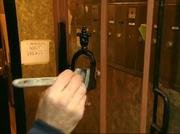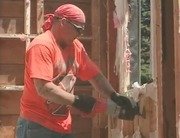More Video Manhattan Remodel and Cape Cod Affordable Cladding, Insulating, and Zoning for an Affordable Home
The Blown-In Blanket Insulation Process
Bob is joined by Mike Hobson of Westchester Insulation as the crew prepares one of the Mashpee houses for insulation installation.
Clip Summary
Bob is joined by Mike Hobson of Westchester Insulation as the crew prepares one of the Mashpee houses for insulation installation. Hobson explains that this is a patented insulation system that uses special fabric stapled and drawn tight across any cavity that needs to be insulated. The crew works with pneumatic staplers to get the fabric in place across all the walls and the joists of the cathedral ceiling. The fabric is not intended as a moisture barrier of any kind and is just there to hold the insulation in place and prevent it from settling. Hobson shows Bob the white fiberglass that will be blown into the cavities. It is white because it is a virgin product, completely free of treatments, binders, or chemicals. Certainteed and Johns Manville both produce fiberglass insulation that is suitable for the Blow-In-Blanket installation. Once all cavities have been enclosed, the insulation contractor cuts a slit in the fabric and inserts a hose through which the fiberglass is blown. The cavity is filled to a density of two pounds per cubic foot which is visible to the eye by a slight bulge in the fabric. At this density, an R-value of 15 is achieved in two-by-four cavities like walls. In attics and ceiling cavities that are two-by-six, an R-value of 38 can be achieved. This insulation is inert and will not support moisture, mold, animals, or insects. It also serves as a sound insulator and can be blown in around drain lines, in interior partitions, and around tubs and showers. Blo-In-Blanket insulation is suitable for new construction or retrofit applications where it is blown in through the sheathing from the outside or through interior drywall to fill wall cavities. Blow-In-Blanket insulation costs about 50 to 60 percent more to install than traditional batt insulation, but offers such energy efficiency that it pays for itself within two to four years.Bob Vila: We're back inside our little house and the fast pace of construction and noise is only good. What we're involved with right now is insulating the house. Mike Hobson is here to tell us about Blow‑in‑Blanket Systems. Mike Hobson: Hey Bob, how are you? Bob: How are you? Nice to have you here. Mike: Thank you very much. Bob: Traditionally when you're doing a fast, small, affordable house like this, they run in and they put fiberglass batt conventional insulation systems. This is a little bit different. How does it work? Mike: It is a little bit different. This is the Blow‑in‑Blanket System. It's a patented insulation system. As you can see, the men are putting up a fabric over the face of any area that needs to get insulation. The walls, you have a cathedral ceiling here, you have some fabric up there. Once they're done stretching that fabric tight we come back in and blow in some fiberglass insulation. Bob: So, the prep work right now involves getting all this fabric material stapled in place? Mike: Correct. Bob: They've got pneumatic staple guns, so that's why they go so quickly. Mike: They've got pneumatic staple guns, move very quickly. The secret is to get, as you can see, he's got it pulled very tight. You want the fabric as tight as you can get it. Bob: Oh, really? Mike: Yeah. Bob: Look at all those staples. Sure. Mike: When it's blown in behind it, you're looking for a certain density, and that's what gives you the R‑value of the insulation. Bob: Is the fabric itself some sort of moisture barrier or anything like that? Mike: The fabric is not a moisture barrier. In applications where you are looking for a specific vapor barrier, after the fact you can come back and put in a polyethylene over top of that. Bob: OK, but in this situation it's strictly there to hold the material in place? Mike: Strictly there to hold the material in place, correct. Bob: Now the fabric's in place, so we're ready to start blowing it in. Mike: We're ready to start blowing some in. Bob: What is it that we're blowing in? This looks different. We're use to pink or yellow batts of insulation and this is different looking. Mike: Blown insulation, when it is white like this, is what they call a virgin product. There's no additional binders that are added to it which hold conventional batt insulation together. This is a material that's manufactured by CertainTeed. CertainTeed and Johns Manville both manufacture products that are acceptable for use in the Blow‑in‑Blanket System. Bob: It looks denser than what I'm used to when I think about fiberglass. Mike: It is. It's blown in. That's the secret to getting the R‑value out of it. In a 2x4 cavity, which is what you have in these homes, you're going to end up with an R15. Bob: As opposed to an R11. Mike: As opposed to an R11 or an R13 that you can get out of batt insulation. That's strictly a function of the density of the material. Bob: With batt insulation we're always told not to compress it because if you compress it you get rid of the air pockets. Mike: Absolutely, but with blown material when you achieve a higher density, which this will be blown in up to a two‑pound density, you can still get an increased R‑value out of it. That's where you get the increase in the R‑value out of the material. Bob: OK. What about in the attic? What do you do up there? Mike: In the attic, in this application, we've put some fabric up already. It's going to be what we would consider an open blow. We're trying to achieve an R‑value of 38 which would be 15 inches. However, you have a cathedral ceiling situation here, as well. You can also achieve an R38 in those. Again, you're compressing and getting denser material, so in a 2X12 you're still going to have an R38 with a blown‑in system. Bob: Does this have any kind of sound‑deadening qualities? Mike: Absolutely, yeah. It has a lot of sound‑deadening qualities to it. Oftentimes, we'll net the interior partitions around bathrooms around tubs, to quiet those down, underneath drain lines, so we do an awful lot. Bob: The truck is out on the street, and that's where all the material is and... Mike: The truck is out on the street. Yep. Bob: It's being pressurized and blown in through there, and the system is real simple. You just go up to the cavity and you slit all of the fabric, right? Mike: Absolutely. Bob: Boy! That goes quick. How does he know when he's got enough in there, Mike? Mike: The secret to this, if you come to the side here, Bob, you can see the netting bulges out. Bob: Yeah. Mike: About probably an inch, or so, and that's how you know. That actually is part of the patent of the system that you have enough in there that you're getting the densities that you want. What we do when we're done, we'll come back and broom that, try and broom that as flush as we possibly can, to make it easier for the drywaller to put his drywall on there. Bob: Do you have to worry about rodents nesting in there or about humidity collecting in there and having it all slump down? Mike: No, not at all. As I said before, it's a virgin fiberglass product. It will not support any moisture at all, any mold growth, or any type of insects or animals. Bob: Is it treated with any kind of... Mike: No, it's not. Bob: Just the pure fiberglass. Mike: The pure fiberglass. Bob: So, in terms of people and allergies, you don't have to worry about that. Oh, that is very quick. Yeah, that's great. Mike: Yeah. Bob: Can this also be retrofitted? If you're doing it in a house that's already built? Mike: It can be. Bob: How do you do it? From the outside? Mike: You can do it either from the outside or from the inside. What we recommend is, if someone is residing an existing house from the outside, you can drill through the sheeting, as he's poking the holes in the fabric. You would drill a hole in it and blow the material in that way. For people remodeling from the inside, you can drill through existing plaster and do it from the inside, if they're going to paint or repaper, or so forth. Bob: The great thing is we're getting the highest R‑Factor that you can get. Mike: In a 2x4 cavity you're not going to get any higher an R‑value out of it. That's the beauty of it. It's something that's a little bit more costly on the front end than conventional batt insulation. A house such as you have here, you're probably looking anywhere between 50‑60 percent more for the insulation on the front end. However, the payback on that with the savings of your utility bills and so forth is probably going to be somewhere in the neighborhood of two years. Bob: Really! That fast a payback? Mike: Absolutely. Bob: In New England that makes a big difference in an affordable house. Mike: It certainly does. Bob: Thanks Mike. Mike: Not a problem, Bob. Thank you.





